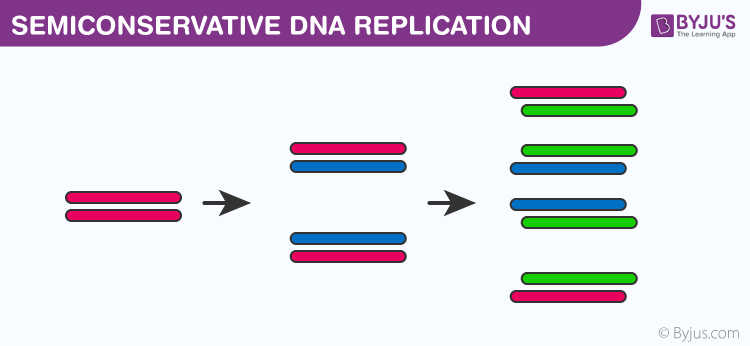3. The biologists proposed three different hypotheses for DNA replication and how Meselson- Stahl proved the way forward for the DNA replication process.
3. The biologists proposed three different hypotheses for DNA replication and how Meselson- Stahl proved the way forward for the DNA replication process.
DNA Replication:
- The process in which the DNA makes multiple copies of itself is known as DNA replication.
- DNA replication is a biological polymerization, which proceeds in the sequence of initiation, elongation, and termination.
- DNA replication is an enzyme-catalyzed reaction.
- DNA Polymerase is the main enzyme in the replication process.
Three types of DNA replication are:
- Conservative DNA replication: It produces two DNA helices, out of which one contains entirely old DNA while the other contains entirely new DNA.
- Semiconservative DNA replication: It produces two DNA helices in which each helix contains one new strand and one old strand.
- Disruptive DNA replication: It produces two DNA helices in which each strand has alternating segments of old and new DNA.
Meselson and Stahl Experiment ;
Meselson and Stahl Experiment was an experimental proof for semiconservative DNA replication. In 1958, Matthew Meselson and Franklin Stahl conducted an experiment on E.coli which divides in 20 minutes, to study the replication of DNA.

Semi conservative DNA Replication through Meselson and Stahl’s Experiment
Experiment
15N (heavy) and 14N (normal) are two isotopes of nitrogen, which can be distinguished based on their densities by centrifugation in Ca,esium chloride (CsCl). Meselson and Stahl cultured E.coli in a medium constituting 15NH4Cl over many generations. As a result, 15N was integrated into the bacterial DNA. Later, they revised the 15NH4Cl medium to normal 14NH4Cl. At a regular interval of time, they took the sample and checked for the density of DNA.
Observation
Sample no. 1 (after 20 minutes): The sample had bacterial DNA with an intermediate density. Sample no. 2 (after 40 minutes): The sample contained DNA with both intermediate and light densities in the same proportion.
Conclusion :
Based on observations and experimental results, Meselson and Stahl concluded that DNA molecules can replicate semi-conservatively. Investigation of semi-conservative nature of replication of DNA or the copying of the cells, DNA didn’t end there. Followed by Meselson and Stahl experiment, Taylor and colleagues conducted another experiment on Vicia faba (fava beans) which again proved that replication of DNA is semi-conservative.
Comments
Post a Comment